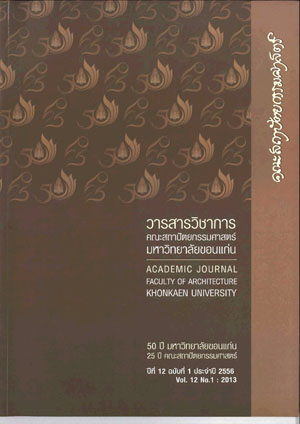บทบาทของสถาปนิกชุมชนกับกระบวนการมีส่วนร่วมในการฟื้นฟูชุมชนเก่า กรณีศึกษา โครงการบ้านมั่นคง ชุมชนบ้านบาตร
คำสำคัญ:
สถาปนิกชุมชน, กระบวนการมีส่วนร่วม, การฟื้นฟูชุมชน, Community Architect, Participatory Process, Community Revitalizationบทคัดย่อ
ตั้งแต่ พ.ศ. 2504 แผนพัฒนาเศรษฐกิจและสังคมแห่งชาติได้สร้างความเปลี่ยนแปลงต่อวิถีการผลิตของชุมชนขนาดเล็กและสร้างวิถีชีวิตของคนเมืองใหญ่ที่ต่างคนต่างอยู่ส่งผลให้เกิดการขาดหายของ “จิตสำนึกชุมชน” ซึ่งส่งผลให้เกิดปัญหาสังคมต่างๆ ขึ้นมากมาย เช่นเดียวกับกรณีของชุมชนบ้านบาตร ชุมชนของช่างทำบาตรด้วยมือที่ถูกผลกระทบกลายเป็นชุมชนแออัดที่มีขาดสุขภาวะในการอยู่อาศัย ผลจากการวิจัยเชิงปฏิบัติการ (Action Research) ผ่านการดำเนินโครงการบ้านมั่นคง ชุมชนบ้านบาตร สามารถสรุปบทเรียนให้เห็นถึงบทบาทของสถาปนิกชุมชนที่เป็นปัจจัยไปสู่ความสำเร็จในกระบวนการฟื้นฟูชุมชน นอกเหนือจากการมีส่วนร่วมในการออกแบบตามบทบาทสถาปนิกทั่วไป คือการมีเป้าหมายเพื่อเพิ่ม “พื้นที่สาธารณะ” ในการเชื่อมต่อ “จิตสำนึกสาธารณะ” ที่ยังหลงเหลืออยู่ของปัจเจกบุคคลให้ เกิดเป็น “สำนึกร่วม” ที่เป็นแรงขับดันกลไกการแก้ปัญหาโดยตัวชุมชนเองต่อไป โดยที่บทบาทดังกล่าวสามารถจำแนกตามการดำเนินโครงการระยะต่างๆ ได้แก่ (1) การเป็นผู้เรียนรู้ที่มีทักษะในการฟัง อ่อนน้อมถ่อมตน และจริงใจต่อชุมชน ในระยะศึกษาข้อมูลเพื่อระบุขอบเขตปัญหา (2) การเป็นกระบวนกร (Facilitator) ที่มีทักษะดี และการเป็นผู้ร่วมผลักดันให้เกิดปฏิบัติการเพื่อการแก้ปัญหา ในระยะการมีส่วนร่วมในการแก้ปัญหา และ (3) การเป็นผู้สังเกตการณ์ ในระยะติดตามการดำเนินการแก้ปัญหาโดยชุมชน ซึ่งทั้งหมดสามารถสรุปเป็นความเข้าใจรวบยอดถึงบทบาทของสถาปนิกชุมชนว่าคือผู้ร่วมเรียนรู้ไปกับชุมชนด้วยเจตนาที่ดี ด้วยความมุ่งมั่นและจริงใจภายในกรอบระยะเวลาหนึ่ง ผ่านกระบวนการมีส่วนร่วมในการฟื้นฟูชุมชน
Roles of Community Architect & Participatory Process in Community Revitalization : A Case Study of Baan Mankong Project Baan Batr Community
Yingyong Poonnopatham
Since 1961, the National Economic and Social Development Plan had impact on the change of the mode of production of small community and caused the individualism through urbanization. This led to the lacking of “Collective mind” that caused many of social problems. In case of Baan Batr Community, a community of artisans producing the traditional monk’s alms bowl, that been changed into an unhealthy slum. The results of the Action Research through the implementation of Baan Mankong Project can be concluded that the role of communityarchitect is the factor in the success of community revitalization. Not only the role in architectural design as a conventional architect, but also the roles in the process of increasing the “Public space” that empower The “public-spirit” that remains of the individual to become the “Collective mind” that drive mechanism to solve the problem by the community itself. These roles of community architect can be categorized in the stage of project implementation including (1) the role as the learner with the Deep Listening skill, humbleness and sincerity to the community in the study to identify the problem stage, (2) the role as a skilled facilitator and the role as the push for problem solving in the participation in problem solving stage and (3) the role as observer in the community action follow-up stage. All of which can be summarized as a comprehensive understanding of the role of the community architect as a community’s co-learner with good intentions, commitment and sincerity within a certain time frame through the participatory process in community revitalization.
ดาวน์โหลด
รูปแบบการอ้างอิง
ฉบับ
ประเภทบทความ
สัญญาอนุญาต
ทัศนะและข้อคิดเห็นของบทความที่ปรากฏในวารสารฉบับนี้เป็นของผู้เขียนแต่ละท่าน ไม่ถือว่าเป็นทัศนะและความรับผิดชอบของกองบรรณาธิการ




